Ball of the Foot Pain
Stress Fracture Foot Pain: [Causes, Symptoms & Best Treatment]
Stress Fracture Foot Pain is very common in the front of your foot, your heel, the 2nd and 5th rays. Use the 100% BEST Treatment Guide to FIX IT NOW!
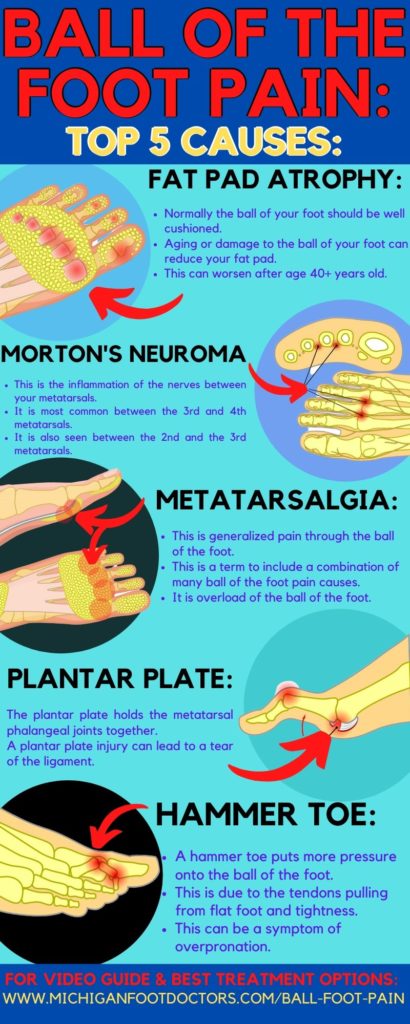
Table of Contents
Ball of the Foot Pain Pictures & Photo Gallery:
Look:
- Metatarsalgia: which means generalized foot pain without a specific cause.
- Second toe capsulitis: this is the inflammation of the second toe joint capsule.
- Capsulitis is related to hammertoe formation, and can lead to a plantar plate tear. There is some overlap between these three disorders. As they get worse tearing and ligament damage can occur.
- Morton’s neuroma: this is the damage and inflammation to the nerves between and underneath the metatarsal joints.
- Fat pad atrophy of the ball of the foot: this is the loss of cushioning in the ball the foot.
- Plantar Plate Tear: A plantar plate tear is ripping of the ligaments holding the toe together.
So, click on the photo gallery to see the specific causes of your ball of the foot pain!
Click on the photo gallery to see the specific causes of your ball of the foot pain!
Presentation of Stress Fracture Foot Pain:
Foot pain due to a stress fracture does not have to be extremely severe. Sometimes if the pain starts out of nowhere and becomes very painful one morning – it is likely not a stress fracture. A stress fracture develops over time and it is due to healthy bone trying to remodel itself over time, leading to weakening. A stress fracture is more of an aching pain that may be very low when you are not running or moving on your foot.
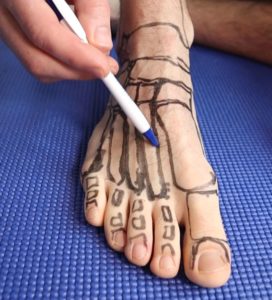
Stress Fractures Symptoms:
- Appear gradually over weeks.
- Aching and throbbing pain.
- Usually in the front of the foot or heel.
- Usually do no appear after obvious trauma.
- Pain and tenderness on weight bearing.
- Pain is worst at the beginning of an activity, gets slightly better later but still aches. Then it hurts the most later.
- Pain is felt in a very concentrated area.
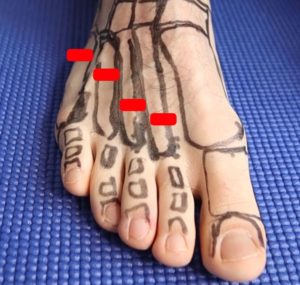
Causes of Stress Fracture Foot Pain:
Every bone in the body is constantly remodeling and regenerating itself; especially during extreme weight bearing! If you are just sitting on the couch the remodeling is not as fast, but if you spend a great deal of time on your feet, it remodels quite a bit!
Two types of cells in your bone are responsible for this phenomenon. First are the osteoblasts which help make more bone. Then there are the osteoclasts which break down bone into its precursors elements like calcium, so that osteoblasts can re-shape the bone. If the osteoclasts are overwhelming the osteoblasts, you are at risk for a stress fracture!
This weight bearing is seen the most during sports and being on your feet all day. It is no secret that people who start training for marathons are the most likely to experience a stress fracture! I even had a roommate who had a stress fracture in his hip due to training for an ultra-marathon!
If your bone is not in peak shape due to years of decreased exercise, be careful when you go for those 5 mile runs! It is a good idea to ease yourself in over the first few weeks, start with a run around the block!

The Muscle Fatigue Theory:
As your muscles fatigue, you may become more susceptible to stress fractures!
- Muscle fatigue can lead to a shift in pressure onto your bones! This is especially common in your feet.
- As your muscles begin to tire out throughout the day, the muscles lose their strength and begin to relax.
- This is seen as a slight flattening of your arches, slumping in your back and bending of the knees or hips.
- This puts uneven pressure on the bones in your feet, ankles and knees.
- This could be enough force to begin the deterioration and weakening of certain sites in your bones.
- It may be just enough deterioration that when combined with extreme weight bearing to lead to a stress fracture.
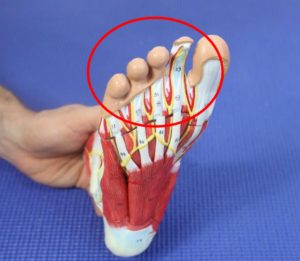
Three Types Get Stress Fracture Foot Pain:
See which one most closely resembles you!
1) Peak Condition Athletes:
- Even an Olympic or world class athlete can get a stress fracture.
- I have seen some amazing athletes run ultra-marathons and get stress fractures in unusual areas.
- With enough stress and enough repetition, anyone can get a stress fracture!
- Athletes like this can get stress fractures in unusual areas outside the foot.
2)Weekend Warriors:
- A weekend warrior is someone who goes from no training to extreme training overnight!
- These are people who are challenged by a friend to run a marathon, even though they haven’t ran in 5 years.
- This is most common in men who want think it’s all mental, its not! Give your bones some time to adjust.
- Start by running around the block, then half a mile, then 1 mile and so on! Don’t start running 3-5 miles every day while being over weight.
3)The Elderly:
- As you get older, your bones get naturally weaker.
- Your bone mass decreases as you age.
- Your hormones decrease , especially in women after menopause!
- Your calcium intake and Vitamin D will decrease as well.
- Go see a doctor and make sure you nutrition and vitamin levels are where they should be. Just be careful not to overdo it!
Potential precursors of Stress Fracture Foot Pain:
- Overuse of your foot.
- Not due to a very forceful injury.
- Starting exercise after resting for a long time.
- No arch supports.
- Poor shoe choices.
- Wearing high heels.
- Flat foot.
- Equinus (poor calf muscle flexibility)
- Osteoporosis.
- Vitamin deficiency.
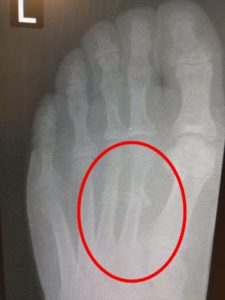
Diagnosis of Stress Fracture Foot Pain:
- Gradual increase in pain.
- Not Severe Pain.
- Usually the base of the 2nd toe, or the outside of the foot.
- Rarely the 1st ray or big toe.
- Women are more susceptible to stress fractures than men.
- History of increased exercise or poor footwear.
- If you have been running or on your feet very heavily after a period of inactivity.
- The pain is usually very light during rest and when you are off your feet.
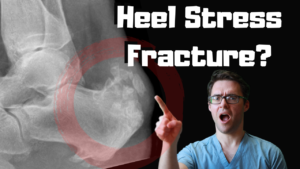
What will happen if you don’t get treatment:
- The pain will build up gradually over a few days.
- There is a high risk of developing a complete break if you do not offload the foot.
- If the bone heals in poor position you will have a permanent deformity.
- If it is near a joint you will 100% develop osteoarthritis.
Home Treatment after the Stress Fracture:
It is difficult to treat a fracture at home. Your main responsibilities should be these:
- Check the above causes and diagnoses.
- Make sure they apply to you.
- If it is a 1st ray pain, it is likely not a stress fracture.
- If it is worse after rest, it is probably more of a inflammatory process and not a fracture.
- If it is worse with activity, it is more likely a stress fracture.
Follow the Home Treatment Guide:
How To Speed Up Healing Of A Stress Fracture.
Types of Stress Fractures:
- Jones Fracture (5th Metatarsal)
- Second Metatarsal.
Why go see a Podiatrist?
- X-rays, MRI’s or Ultrasound scans can be used to look inside the foot to view any damage.
- Blood tests may be taken to diagnose any underlying medical causes such as diabetes or gout.
- A podiatrist may assess your foot position and gait (walking pattern).
- Custom orthotics (insoles) can be made.
Best Foot Stress Fracture Treatment:
- There are usually two phases to bottom of the foot pain treatment.
- The two phases of treatment include controlling the acute inflammation, and correcting the biomechanics which led to the problem in the first place.
- If the tendons and ligaments are inflammed, they are almost frozen in place and cannot function properly.
- Once the inflammation is decreased, we need to correct the biomechanical causes to ensure that they can never become over worked and inflammed again!
- This doesn’t matter whether it’s plantar fasciitis, plantar fibroma, sore bottom of foot, or even Achilles tendon pain. Treatment is all roughly very similar.
Foot Stress Fracture Inflammation Control:
Massage & Ice Products:
- Ice is the an excellent option that can be safe for almost everyone.
- There is some debate whether icing is worth doing, but for chronic pain this can help limit the need for medications and keep your options open.
- This works great for your arch, less for the ball of the foot.
- The more muscle and ligament tissue there is, the better ice will work there.






Menthol Based Gels:
- Biofreeze is one of our favorites.
- These gels have been studied to work 2x as long as ice.
- This works great for the ball of the foot.
- This can be very effective for bottom of the heel and Achilles tendon sore regions.








Massage Sticks:
- These can work great for loosening your muscles.
- This allows less tightness and pressure on the ball of your foot.
- This is very effective for the arch, the gastrocnemius or calf muscle and for the hamstring and thigh muscles.
- This also works very well for the gluteus muscles if you are having butt cheek or hip pain.






Removing The Stress:
- The key is to prevent future pain.
- If you can get rid of the pain and swelling, this will let you start walking normally.
- If you can walk normally, the vast majority of your pain should gradually start to go away.
- The best way to ensure that your plantar fascia, foot and ankle ligaments are not overworked is to support them.
- The best way to support them is to use great orthotics and great shoes.
- Some people may also need to rely on supportive ankle braces and other supportive modalities.
Best Foot Stress Fracture Shoes:
- Getting a great supportive pair of shoes will make sure that there is pressure removed from the heel and plantar fascia region.
- This is especially important if you have plantar fasciitis, heel spur pain or Achilles tendonitis.
- Consider shoes combined with a good supportive orthotic for best pain relief!
- The following link will show you what our favorites are.
Best Foot Stress Fracture Orthotics:
- These are our recommended orthotics.
- There are different types for different shoes.
- Women’s shoes usually need a less bulky orthotic, but allow for less correction.
- A full length orthotic requires a running shoe, boot or comfortable walking/dress shoe.
- We recommend doing everything you can to get a good supportive shoe that can fit a full length orthotic.
- This is the best way to maximize your orthotics for great results.
Best Full Length Orthotics:
- These will only work in wider shoes or a good supportive running shoe.
- This will not work in sandals, flats or most women’s dress shoes.








Best Dress Shoe Orthotics:
- These are a great choice for dress orthotics.






Best 3/4 Length Orthotics:
- These are great options for women’s dress shoes and thinner shoes.
- These are not the most supportive pair of orthotics.


Get A Great Dynamic Stretch:
- It is possible to stretch on your own, but these products can also really help!
- This will take pressure off of the ball of your foot.
- We personally prefer this method of stretching.








Get A Great Static Stretch:
- These devices are great for stretching while you are resting.
- This will also help take pressure off of the ball of your foot.
- This works great for plantar fasciitis.
- It can be used while watching TV or at night time.






Ball of the Foot Pain
